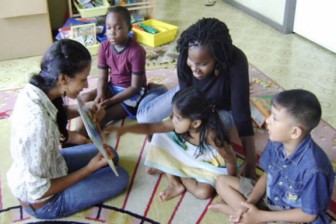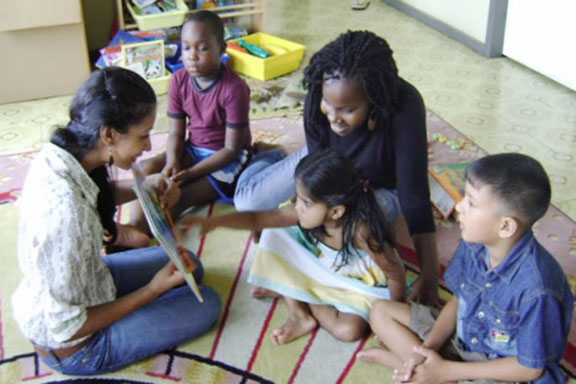Kala Ramnath is a mother of two, autism advocate and member of the Board of The Step by Step Foundation
By Kala Ramnath
Life with autism is a daily reality for millions of families around the world. It is an equal opportunity condition: you can be rich or poor, middle-class or working class. It doesn’t discriminate by race, region or religion. Neither is age. Recent research suggests a link with older parents. However, I have met enough young parents of children with autism to certainly question this idea. The Caribbean – and Guyana in particular – is no exception. There are no figures, no surveys, no analysis on the incidence of autism in Guyana. The US currently uses a figure of 1 in every 90 kids being born with the disability. So even if we are to be generous with this figure and extrapolate, to say 1 in 100 Guyanese kids, we are looking at any one time of about 5000-6000 Guyanese on the autism spectrum. Ignorance about the condition by Guyanese professionals and the public is still widespread which means many autistic children are likely to either be hidden away or, be mis- or un-diagnosed.


The diagnosis – if you are fortunate enough to have access to a skilled doctor/paediatrician able to spot these things -comes. He is on the autism spectrum: where ‘high functioning’ means he might do well at school, but with extremely poor social skills which cause no end of problems throughout his life, even leading to suicide; and ‘low-functioning’ where he cannot access an education because he cannot, speak, concentrate, has outbursts and is socially marginalized.
You are angry at everyone: your spouse, the doctor/paediatrician, God, life, the world, even other people for having ‘normal’ children. Your relatives do not want to know about your ‘problem child’. Your ‘in-laws’ shun him and favour their other grandkids. You cry uncontrollably because you look at your child and see all your dreams for him slowly dissipate: conversations about everything he should have been interested in, playing football or cricket with him in the yard, the sports days, the numerous school graduations, the gawky teen phase, the university, the first crush, the love interests, the marriage, the good job, the grandchildren, the good life…all up in a whiff of smoke. Gone. Just like that.
Your marriage might suffer as divorce rates are way higher than average for parents of autistic children. As a single mother it would be impossible to afford specialist care or schools if they exist and hold down a full-time job, especially if you are an unskilled worker. You start to neglect yourself, go into a depression spiral, your other kids suffer, your autistic child needs your help more than ever…you need help for your child more than ever. Behavioural problems are getting worse. He’s smearing excrement on the walls, you have to lock the fridge and cupboards as he would eat everything, given the chance. You have to lock windows as he does not recognize danger so will climb anywhere. You have to lock doors as he would head out the door and keep walking, given the chance. You stop going out. Limes and outings are ancient history. His only time of peace is when he sleeps. But even that does not last long as if he is not sleeping fitfully, he is shouting for food and drink at two in the morning. Reasons for hope are thin on the ground. Is there an end to these feelings of helplessness, hopelessness; this nightmare?
Welcome to the world of the autistic child and family, an unforgiving drama unfolding in a house somewhere near you anytime, anywhere. The details and the magnitude might vary – we have experienced some of the above with our autistic son, and the other experiences have been related to me by other anxious parents. Each child with autism presents differently. The tell-tale signs are, however, sadly the same.
Autism can be a dark, forbidding and lonely place. But you love your child and you want to help him. Where do you turn to? If you are fortunate enough to live in the developed world, masses of health workers, therapists and consultants will be regularly descending on your front door before too long, having been penciled in on your ‘people to see list’. Your child will be tested, re-tested many times and diagnosed, and placed in a school where appropriate 1:1 intensive behaviour-based education is offered to help him achieve his potential, whatever that might be.
If you live in a developing country – like Guyana and other Caribbean countries – however, the outlook is not so rosy. If you look after him he will be with you and be dependent on you literally for the rest of your life. You worry and fret about this new reality. What’s going to happen to him when you die, you ask yourself. You don’t want to burden his brothers and sisters with his care. Your financial means determines everything. If you are middle class you might be able to afford a minder(s). If you are a poor market vendor, you might keep him close to you – or if needs be – tether him to a post out of the line of vision of others so he can be kept out of danger. You might even leave him in the care of a kind neighbour one of whose relatives might have started to physically or sexually abuse him. You might lash out at him yourself out of ignorance and frustration. You might even opt to take him to a children’s home, crying your eyes out as, bewildered and confused, he watches you walk out the door. You get advice from the neighbours, see something on Oprah and do the best that you can. But it doesn’t amount to much at the end of the day…
You’re getting older with less energy and the added stress is taking its toll. The others have left home. But he’s still there. With you. Needing your help. 24/7. He’s a strapping 6 foot tall adult now and you still do everything for him. Breakfasts, lunches, dinners, bath him, wipe his bum, button his shirts, pull up and zip his trousers, wash his hands, put him to bed…. And then the cycle begins again the next day. Your friends might be close to retirement and looking forward to visits from their kids and grandkids back home from abroad for the summer holidays. They ask how you’re doing. You say – with great difficulty – that you are still trying to toilet train your son, but that he’s not that bad at all, actually. Far-fetched? Not really. It’s the hidden reality of life with an autistic child.
There is no cure for autism to date. Drugs are prescribed for children but this invariably masks the underlying problem and even current research doubts its efficacy. Behaviour modification has proven to be the game changer. It does not remove the autism but helps children to better understand themselves and the world around them. Applied behavioural analysis (ABA) has been around since the 1970s, originating in the US and is now widely used across the USA, Canada and the UK to help kids and young people with autism to learn life skills and access the wider world, to tap into their own individual potential: wider education, even to venture into tertiary level for the higher-functioning. Extensive academic research has shown this method works – even for the most behaviourally-challenged – and is more effective than other approaches.
The Step by Step School is unique in Guyana and the Caribbean. We are the only full-time school for children with autism following this ‘state-of-the-art’ approach and we are very proud of this fact. But we must appreciate that this is only a small, albeit significant, beginning. There is still a long way to go, and much to learn and to do.
The thought that this type of teaching could be extended to Guyanese kids germinated from idea to reality in three years when finally, in 2011 the Step by Step Foundation was registered as a friendly society with the main goal of helping children with autism to access 1:1 therapy and teaching through the ABA approach. The approach depends on closely monitoring progress via recording data in specific learning categories one is able to track each child’s progress on a daily basis. This is what we do daily at our small school in Bagotstown with our complement of 5 tutors and 6 autistic children (increasing all the time) under the supervision/training of Dr Ellis,who visits regularly to conduct assessments and training and has fully and voluntarily committed to working with, and for our Foundation. The Foundation in turn is run by our Executive, made up exclusively of volunteers, led by our Chair, the redoubtable Dr Suraiya Ismail, an internationally-recognised expert consultant in the field of nutrition, who has now also energetically taken up the cause of children with autism in Guyana
The setting up and running of a foundation and school offering high quality state of the art help to Guyanese children with autism has been a collective labour of love for all of us: executive, parents and donors. However, to achieve our goals and objectives requires urgent and sustained long-term funding and support. The Step by Step Foundation has grown and developed with the help and support since 2009 of a huge number of Guyanese and non-Guyanese donors too numerous to mention and we are eternally grateful to all of them. They know who they are. We are currently well short of our budgetary demands. If you would like to help us continue to develop and expand our much-needed work in Guyana, here are our details:
Name of Organization: The Step by Step Foundation
Our Bank: Republic Bank Guyana (Main Office)
Address of Bank: 38-40 Water Street, Georgetown, Guyana
SWIFTCODE (for those overseas): RBGLGYGG
Account Number: 651 5761
Postal address/Tel Contact: 4, Ogle Public Road, East Coast Demerara, Guyana (Tel 592 222 2633)
School Address: Lot 3, Bagotstown, EBD, Guyana.
We can be contacted at sjismail@yahoo.co.uk, or stepbystepf@yahoo.com or kalawatie@hotmail.com. Become a friend of Step by Step Guyana on Facebook where you can get updates on all things autism, and info on our activities. Our website will be up soon! (Please forward us your details if you have contributed so that it can be acknowledged)






